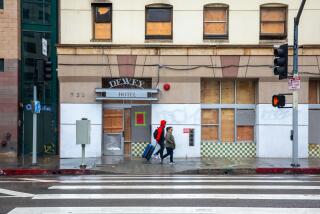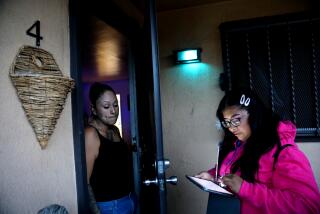Editorial: Cut the red tape already and start building supportive housing for the homeless
Here is a smart way for the Los Angeles City Council to jump-start the building of housing for homeless people: Cut the red tape that delays the construction of supportive housing and the conversion of dilapidated motels into new apartments.
The Planning Commission endorsed a pair of ordinances to do just that last month. Under the proposed Permanent Supportive Housing Ordinance, qualified projects that combine housing with on-site case management and other services for homeless people would be eligible for an expedited review by city officials. If a project meets all the ordinance requirements, it wouldn’t have to go to the City Council for approval to build.
The proposed Motel Conversion Ordinance, meanwhile, would allow a conversion into homeless housing to go forward even if the motel didn’t conform to current zoning requirements. Because no new construction is involved, converting motel rooms into apartments (typically by adding small kitchens) is considered a faster, more economical way to produce housing.
We need all this housing, and city and state governments are, increasingly, encouraging it. For example, a 2008 state law allows permanent supportive housing to be built in any multifamily residential zone as long as it meets all the requirements that any other housing development faces. And the city of Los Angeles is using a $1.2-billion bond issue that voters approved in 2016 to help finance 10,000 units of housing, most of it supportive housing for homeless people.
The city is suffering from both an affordable housing shortage and a homelessness crisis.
The permanent supportive housing ordinance would help in a number of ways. Currently, a proposal to build 50 or more units of housing of any kind automatically triggers a site plan review by the city’s planning department staff — a hurdle that many developers are avoiding by holding their projects to 49 units or less. According to the city planning department, about 55% of permanent supportive housing projects built since 2008 had 49 or fewer units — even when the parcel size and zoning would have permitted more. If the city is going to get 10,000 units of permanent supportive housing built in 10 years, then developers shouldn’t be discouraged from building as many units as their sites will support.
Under the new ordinance, a site plan review would be required only for projects with 120 or more units in most of Los Angeles. The threshold would be even higher — 200 units — in downtown Los Angeles.
In other cost- and space-saving measures, the ordinance would allow developers to build more, smaller units than they could on a conventional housing project, and it would reduce the number of parking spaces required at such developments. No spaces would be required for any housing units reserved for homeless individuals. That makes sense — the projects are near transit stops, and homeless people are hardly the typical commuters.
The measure imposes its share of demands on developers. To be eligible for the ordinance’s benefits, developers would have to find sites within a half-mile of a transit stop, meet design standards, earmark at least 50% of the units as supportive housing for homeless people with a physical, mental health or a substance abuse problem, and reserve the rest for low-income renters.
Eligible projects must also be located in a zone that allows multiple unit dwellings, with one exception: Joint public-private projects — such as the planned developments on city-owned property — that are located in public facilities zones will be allowed to build to the standards of the least restrictive adjacent zone.
Both of these ordinances are measured and smart, and city officials should move them through the gantlet of council committees quickly. Contrary to what some critics might suggest, this is not a stealth attack on the character or integrity of neighborhoods. While the supportive housing ordinance would allow more density, it wouldn’t open the door to massive housing projects being wedged into residential communities. No one is building the next Jordan Downs barracks-style housing project. (Even Jordan Downs is being torn down to make way for a new kind of development.)
The city is suffering from both an affordable housing shortage and a homelessness crisis. Whatever city officials can sensibly do to speed up the building of housing for homeless people, we expect them to do it.
Follow the Opinion section on Twitter @latimesopinion or Facebook.
More to Read
A cure for the common opinion
Get thought-provoking perspectives with our weekly newsletter.
You may occasionally receive promotional content from the Los Angeles Times.






